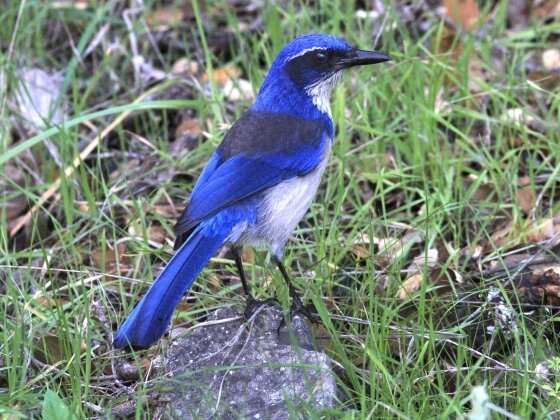Strategies found for protecting island scrub jays from West Nile virus

In Channel Islands National Park off the coast of California lives the island scrub jay, a vivid blue and gray songbird with a species population of around 1,700. The rare species makes its home exclusively on Santa Cruz Island, about 18 miles off the coast of Santa Barbara in a lush nature preserve of oak woodland and chaparral vegetation.
It has survived on the island for over 500,000 years, but its wellbeing and existence might be in danger due to a growing threat of West Nile virus, linked to climate change. Because the virus replicates more efficiently in mosquitoes when temperatures are warm, this cool maritime island is increasingly likely to host the disease.
A study published this week and led by Montana State University assistant research professor Victoria Bakker discusses a strategy that could improve the scrub jay's long-term viability in the face of that threat.
The paper, published in the journal Diversity and Distributions, suggests establishing a second population on neighboring Santa Rosa Island through translocation—the purposeful moving of a species from its existing range to a new location to support conservation. Santa Rosa Island has a cooler climate and, therefore, the researchers hypothesize, a lower risk of West Nile virus. It also recommends using targeted West Nile vaccination on both islands if jay populations decline.
"We focused on one of the few proposals to carry out such a geographic range expansion for a specific species and threat," said Bakker, the paper's lead author and a conservation biologist in MSU's Department of Ecology in the College of Letters and Science. "And to our knowledge, our study is the first to analyze the potential to reduce extinction risk using a conservation translocation strategy."
Native only to Santa Cruz Island, the island scrub jay has the smallest range of any bird in continental North America. Because of its isolation, the species is deemed "immunologically naive," or inexperienced with pathogens and viruses, making it vulnerable to pathogens that are already widespread in birds across North America. As an example, the California scrub jay, the most closely related species to the island's population, has a mortality rate of close to 85% when infected with West Nile, underscoring the need for protections for the island scrub jay, Bakker said.
Bakker and the team of researchers found that under current virus-free conditions, the extinction risk for island scrub jays was close to zero but increased to over 20% with simulated virus outbreaks.
"This 1-in-5 odds of extinction is far higher than acceptable risk levels that are used in the U.S. or internationally and show that West Nile virus is an urgent threat to the continued existence of this species," said Daniel Doak, a professor of environmental studies at the University of Colorado and one of the paper's co-authors.
Bakker said that while translocations are increasingly common proposals, carrying them out is uncommon. But there have been some tentative success stories. One such example was the recent movement of threatened bull trout to lakes that do not contain nonnative lake trout in Glacier National Park by a team including Christopher Guy, also a professor in the Department of Ecology who works with the U.S. Geological Survey's Montana Cooperative Fishery Research Unit.
Another benefit of the translocation strategy is the potential for the jays to accelerate habitat recovery of Santa Rosa Island after over a century of intensive grazing. According to Scott Sillett, a co-author and head of the Smithsonian Conservation Biology Institute's Migratory Bird Center, scatter-hoarding island scrub jays function as "accidental gardeners" and plant thousands of oaks each year.
"This behavior would spur recovery of island chaparral habitat after 150 years of grazing by sheep and cattle," Sillett said.
The researchers used years of population data for the jay and a computer simulation to evaluate the two approaches to safeguard the species. Although vaccination often outperformed translocation in reducing the risk of extinction, only scenarios that included both approaches achieved acceptably low species-wide extinction risk across the broad range of possible future conditions.
"This study provides a clear strategy to protect the island scrub jay for future generations and a template for carefully assessing the value of conservation translocations for other species and threats," said Scott Morrison, a co-author and director of Science for The Nature Conservancy in California.
More information: Victoria J. Bakker et al. Translocation with targeted vaccination is the most effective strategy to protect an island endemic bird threatened by West Nile virus, Diversity and Distributions (2020). DOI: 10.1111/ddi.13109
Journal information: Diversity and Distributions
Provided by Montana State University



















